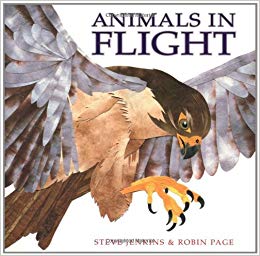Animals in Flight
Animals in Flight written by Steve Jenkins and Robin Page

Topic: Adaptations
Description:
This book examines the topic of flight in a number of different animal species, over half of which are birds. From the delicate transparency of a dragonfly’s wing to the sturdy sleekness of an Albatross, the textures and colors of each cut-paper-collage illustration beautifully captures the feature it portrays.
A unique aspect of this informational book is that it is written at three different levels. For each illustration, there is a bold, declarative statement making it a perfect read aloud for even the youngest audiences. There is a more informative paragraph for each illustration, providing a bit more information about the species or feature described. Finally, there are smaller illustrations with accompanying detailed text, expounding upon the concept or applying it to additional species. This provides a starting point for students who want to know more about those ideas that interest them.
Find Animals in Flight on Amazon.
Activity 1: Taking Flight – Flying and Migration!
Explore bird flight and migration in the third lesson in our Feathered Friends resource. In this lesson, students learn about the different ways birds can fly — soaring, gliding, swooping, hovering — and the basic principles of flight. They also learn why some birds migrate and the hazards they face while doing so.
Activity 2: Whose Wings are These
Explore common wing shapes of birds by studying diagrams of four typical wing shapes. Discuss how each wing type is adapted for a different type of flight and have children come up with a list of birds for each wing type. For older groups, download the Bird Wing Types handout to scaffold learning.
Activity 3: Making Wings
Make flying “birds” (paper airplanes colored to look like birds). Encourage children to try making different wing types. You might want to provide different colors of paper and/or colored pencils for children to decorate their bird. After making the birds, launch your “flock” outside or in a large room. Observe variations in flight: how far each bird flies, its flight pattern, how long it stays up, etc. If you have time, have the children modify their bird and notice whether these changes impact the “bird’s” flight.
Activity 4: Flap Like a Bird
Not all birds fly in the same way. Turkey Vultures soar for hours without much wing movement, while hummingbirds flap their wings over 70 times a second as they fly forward, hover in place, and even fly backward.
Have students hold their arms out like wings. (With older students, you can show a diagram of a bird skeleton to compare its wings to human arms.) Have your students practice flapping. See how long they can keep up an easy flapping pace, about one flap per second, before they get tired. Tell them a thrush can travel 3,000 miles from Panama to Canada, its wings beating more than 6,000 times per minute or 3.2 million beats from start to finish. It averages about 158 miles per night of flight. Ask if their arms ache a bit from flapping. They should notice that their outer chest muscles and arm muscles are tired. Explain that since we walk to get around, our leg muscles are often more fully developed than our chest muscles. Some birds, like turkeys, chickens, ostriches, and other walking birds also have well-developed leg muscles.
To compare the different wing beats of birds, copy the following table on the board or on chart paper. Ask students to decide which rate of wing beat they think they can match. For younger children, consider having the whole group flap together, starting with the flapping rate of an American Crow, an American Robin, then a Rock Pigeon. By the time you get to the European Starling, kids should find it impossible to keep up. For older students, divide the class into pairs and have one student keep time while the other flaps. Then have them change jobs.
Wing Beat Table
| Bird Species | Wing Beats/10 second |
|---|---|
| American Crow | 20 |
| American Robin | 23 |
| Rock Pigeon | 30 |
| European Starling | 45 |
| Black-capped Chickadee | 270 |
| Ruby-throated Hummingbird | 700 |
Additional Resources
Learn more about migration and explore migration obstacles with The Cornell Lab of Ornithology K-12’s Habitat Connections curriculum.